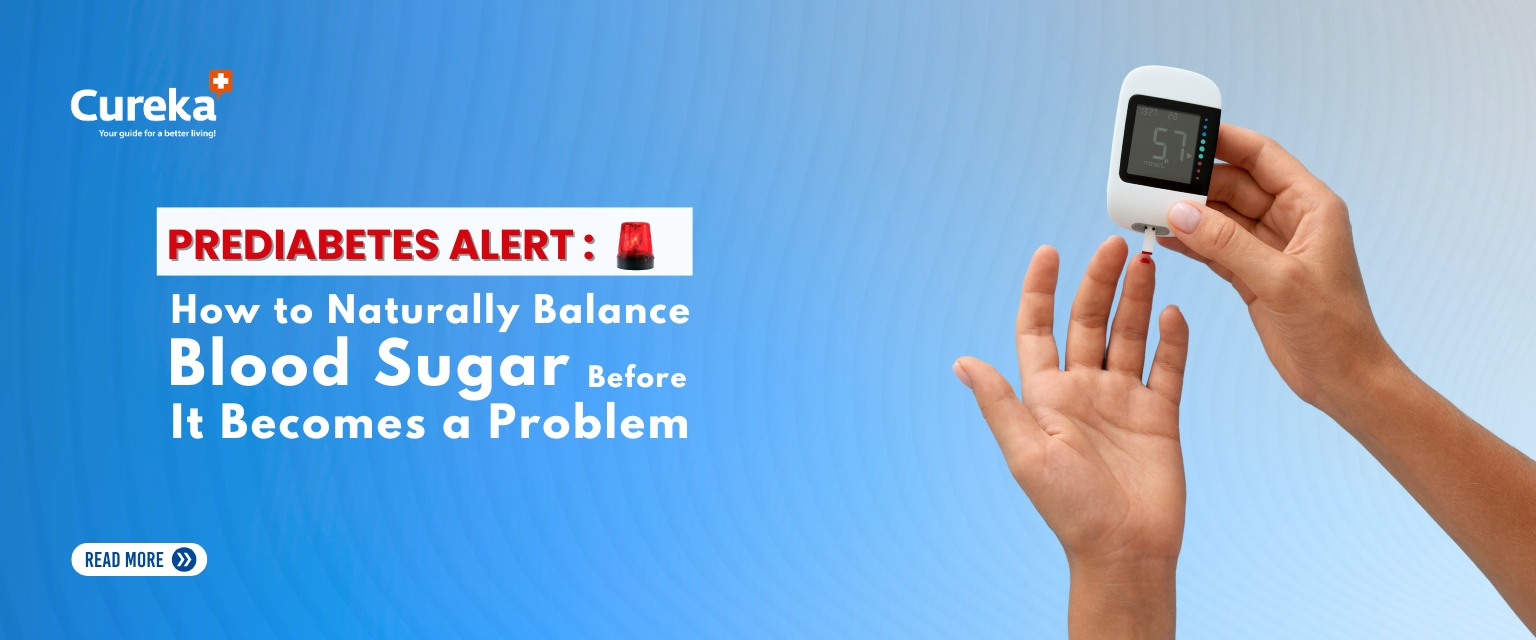Prediabetes Alert: How to Naturally Balance Blood Sugar Before It Becomes a Problem
Prediabetes is the silent stage before diabetes fully develops. It often creeps in without strong warning signs but gives you one precious gift: a chance to reverse it before it turns into type 2 diabetes. Understanding how to lower blood sugar naturally , what symptoms to watch for, and which foods and habits support natural blood sugar control can dramatically reduce your risk of progression.
In this comprehensive guide, we’ll explore whether hereditary diabetes can lead to prediabetes, what symptoms to be aware of, and how even those with no family history can end up at risk. We’ll then provide natural and dietary solutions, including a list of foods to lower blood sugar, herbal juices, and preventive products you can consider adding to your daily routine.
Let’s start with the basics.
Is Hereditary Diabetes a Risk Factor for Prediabetes?
Yes, absolutely. If your parents or siblings have diabetes, you are at a significantly higher risk of developing prediabetes. Genetic factors influence how your body processes glucose and responds to insulin. However, heredity alone doesn’t determine your fate.
People with a genetic predisposition to diabetes may notice that they gain weight easily, have trouble losing it, or feel unusually fatigued after meals. These are early signs of insulin resistance, the hallmark of prediabetes. If you have a family history of diabetes, it’s essential to understand how to lower blood sugar naturally before it turns into a lifelong health concern.
But what if diabetes doesn’t run in your family?
How People Without Family History Still Get Prediabetes
Even without a genetic link, you could be at risk due to lifestyle habits. Modern living has brought with it some dangerous patterns:
- High intake of refined carbs and sugars: White bread, pastries, sodas, and packaged snacks all spike blood sugar rapidly.
- Lack of physical activity: Sitting for prolonged hours without movement impairs glucose utilization.
- Chronic stress: Elevated cortisol can lead to increased insulin resistance.
- Poor sleep hygiene: Less than 6 hours of sleep regularly is linked with higher blood glucose levels.
- Skipping meals: Especially breakfast, which can disrupt your body’s glucose regulation throughout the day.
Whether your risk is hereditary or acquired, these factors combined can push your blood sugar into the prediabetic range.
This is why adopting a prediabetes diet, practicing natural blood sugar control, and learning how to lower blood sugar naturally is important for everyone, not just those with a family history.
Early Symptoms of Prediabetes You Shouldn’t Ignore
Prediabetes can be tricky to detect, but there are some signs that may suggest your blood sugar is on the rise:
- Fatigue after meals
- Blurred vision
- Increased hunger and thirst
- Frequent urination
- Darkened skin on the neck, elbows, or knuckles (a condition called acanthosis nigricans)
- Difficulty concentrating or feeling foggy after eating
- Increased cravings for sweets or carbs
If you notice any of these symptoms, it’s time to evaluate your lifestyle and consider getting your fasting blood sugar and HbA1c levels checked.
The Power of Natural Prevention
If you’ve been told you’re prediabetic, don’t panic. This is the phase where diet, exercise, and simple lifestyle changes can help you reverse the condition. Let’s break down how to lower blood sugar naturally using real, proven methods.
The Prediabetes Diet: What to Eat and Avoid
A prediabetes diet doesn’t need to be complicated. It’s about making smart, sustainable food choices that don’t spike your glucose. Here are some practical guidelines:
- Focus on Foods to Lower Blood Sugar
- Leafy greens (spinach, kale, arugula)
- Non-starchy vegetables (cauliflower, broccoli, zucchini)
- Legumes (chickpeas, lentils, kidney beans)
- Whole grains (Prefer Indian whole grains like millets (ragi, bajra, jowar), whole wheat rotis, steel-cut oats, and unpolished brown rice in moderation. These are rich in fiber and help support natural blood sugar control.)
- Healthy fats (groundnuts (peanuts), flaxseeds (alsi), sesame seeds (til), coconut, homemade ghee (in moderation), and cold-pressed mustard or groundnut oil.)
- Lean proteins (chicken, fish, paneer)
- Low-GI fruits (berries, apple slices with skin)
These are excellent foods to lower blood sugar while providing essential nutrients.
What to Avoid
- White bread, white rice, and refined flour
- Sugary drinks and packaged juices
- Pastries, cookies, and sweetened cereals
- Fried foods
- Alcohol in excess
Herbal Juices for Natural Blood Sugar Control
Herbal juices can act as gentle yet effective tools for natural blood sugar control. Below are some of the best choices:
- Bitter Gourd (Karela) Juice: Contains compounds like charantin and polypeptide-p, which mimic insulin activity.
- Amla Juice: Boosts pancreatic function and enhances glucose metabolism.
- Fenugreek Water: Soak fenugreek seeds overnight and drink the water in the morning to help stabilize blood sugar.
- Cinnamon Water: A natural insulin booster; helps improve fasting blood sugar.
- Neem Juice: Traditionally used in Ayurvedic medicine for blood purification and sugar control.
Incorporating one or two of these into your daily routine can help you discover how to lower blood sugar naturally using traditional, plant-based approaches.
Supplements and Preventive Products to Consider
In addition to a prediabetes diet and herbal remedies, some natural supplements can offer extra support:
- Berberine: A plant compound shown to lower blood sugar as effectively as some medications.
- Chromium Picolinate: Enhances insulin sensitivity.
- Magnesium: Low levels are linked to insulin resistance.
- Alpha Lipoic Acid (ALA): An antioxidant that supports glucose uptake.
- Gymnema Sylvestre: Helps reduce sugar absorption in the intestine.
- Jamun Seed Extract: Traditional Indian remedy to balance blood sugar.
Always consult a healthcare provider before adding supplements to your regimen.
Lifestyle Habits That Make a Difference
Understanding how to lower blood sugar naturally isn’t just about food—it’s a lifestyle:
1.Exercise Regularly
Aim for 30 minutes a day: brisk walking, yoga, swimming, or strength training.
2.Sleep Well
Target 7–8 hours of uninterrupted sleep each night to regulate hormones.
3.Manage Stress
Practice meditation, journaling, or deep breathing exercises.
4.Stay Hydrated
Water helps your kidneys flush out excess sugar.
5.Eat on Time
Don’t skip meals; this helps maintain steady blood glucose throughout the day.
Diabetic-Friendly Protein Powders:
When managing blood sugar , maintaining balanced nutrition is crucial. Diabetic-friendly protein powders can be a smart addition to your routine. These powders are specially formulated to have low glycemic index ingredients and often include added fiber and essential nutrients that support natural blood sugar control.
Using a quality protein powder helps stabilize blood sugar levels, supports muscle health, and keeps you feeling full longer making it easier to stick to your prediabetes diet. Look for powders made from plant-based sources like pea, hemp, or brown rice protein, and avoid those with added sugars or artificial sweeteners.
Including diabetic protein powders can be another effective way to learn how to lower blood sugar naturally, especially when paired with a balanced diet and active lifestyle.
Conclusion:
Prediabetes doesn’t have to turn into diabetes. Whether your risk comes from your genes or your habits, you have the power to reverse the condition naturally. Adopt a structured prediabetes diet, embrace foods to lower blood sugar, drink beneficial herbal juices, and make lifestyle choices that support long-term health.
The earlier you begin, the better your chances. Learn how to lower blood sugar naturally, stay alert to symptoms, and be proactive. Natural prevention is not just safer, it’s sustainable, empowering, and life-changing.
References:
- Pre-Diabetes and What It Means: The Epidemiological Evidence – 2021 dec – https://pmc.ncbi.nlm.nih.gov/articles/PMC8026645/
- Prediabetes: A high-risk state for developing diabetes – 2014 Jan – https://pmc.ncbi.nlm.nih.gov/articles/PMC3891203/
- Interventions for Reversing Prediabetes: A Systematic Review and Meta-Analysis – 2022 Apr – https://pubmed.ncbi.nlm.nih.gov/35151523/
- Prediabetes and lifestyle modification: time to prevent a preventable disease – 2014 – https://pubmed.ncbi.nlm.nih.gov/25102521/
- Prediabetes: the importance of early identification and intervention – 2010 Jul – https://pubmed.ncbi.nlm.nih.gov/20675976/











